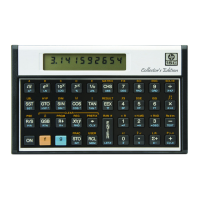Section 13: Finding the Roots of an Equation 181
The basic rules for using _ are:
1. In Program mode, key in a subroutine that evaluates the function
f(x) that is to be equated to zero. This subroutine must begin with a
label instruction (´ b label) and end up with a result for f(x)
in the X-register.
In Run mode:
2. Key two initial estimates of the desired root, separated by v,
into the X- and Y-registers. These estimates merely indicate to the
calculator the approximate range of x in which it should initially
seek a root of f(x) = 0.
3. Press ´ _ followed by the label of your subroutine. The
calculator then searches for the desired zero of your function and
displays the result. If the function that you are analyzing equals
zero at more than one value of x, the routine will stop when it finds
any one of those values. To find additional values, you can key in
different initial estimates and use _ again.
Immediately before _ addresses your subroutine it places a value
of x in the X-, Y-, Z-, and T-registers. This value is then used by your
subroutine to calculate f(x). Because the entire stack is filled with the x-
value, this number is continually available to your subroutine. (The use of
this technique is described on page 41).
Example: Use _ to find the values of x for which
f(x) = x
2
− 3x − 10 = 0.
Using Horner’s method (refer to page 79), you can rewrite f(x) so that it is
programmed more efficiently:
f(x) = (x − 3)x − 10.
In Program mode, key in the following subroutine to evaluate f(x).
Keystrokes Display
| ¥
000-
Program mode.
´ CLEAR M
000-
Clear program memory.

